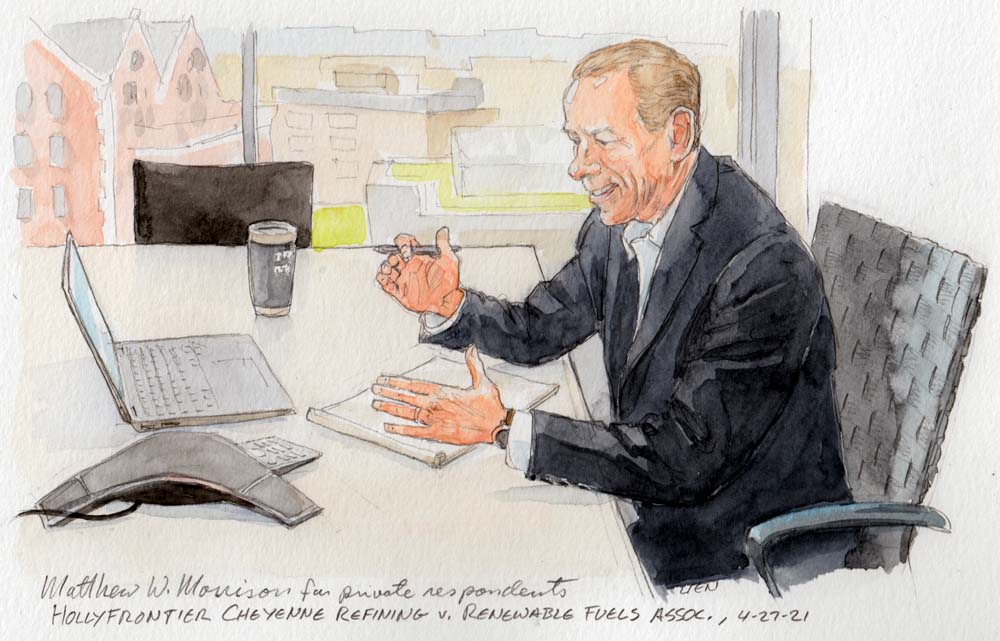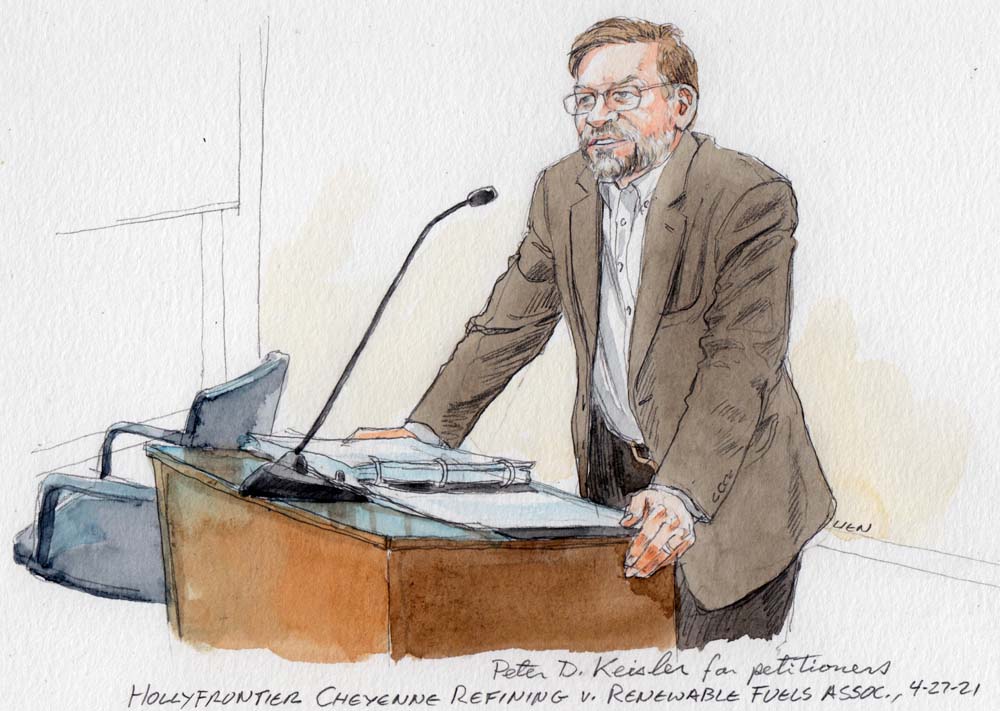Justices and litigants spar over whether renewable-fuel law creates a “funnel” or a “safety valve”

The Supreme Court heard oral argument Tuesday in HollyFrontier Cheyenne Refining, LLC v. Renewable Fuels Association, which considers whether small refiners can take advantage of a compliance exemption in the Renewable Fuel Standard program if they have not received that exemption continuously. (The full statutory scheme is elaborated here.) The petitioners are three small refineries who argue that the word “extension” in the statute’s exemption language provides a metaphorical safety valve for small refiners who would suffer disproportionate economic hardship in any given year if required to comply with the program. The respondents, several renewable fuel associations, contend that the provision is more like a funnel, designed by Congress to achieve full compliance with the standard over time such that an extension would be available only to those who had continuously received an exemption. In an additional wrinkle, the federal government was originally aligned with the refineries’ view, but following the change in presidential administration, it switched its position before the court.
Coming into Tuesday’s argument, the main themes in the parties’ briefs centered on approaches to statutory interpretation. But the parties had also debated whether deference to the Environmental Protection Agency would be appropriate under the doctrine of Chevron USA, Inc. v. Natural Resources Defense Council, Inc., given a 2014 EPA regulation that interpreted the meaning of small refineries in a way consistent with an overall safety-valve approach. Early in his questioning of Peter Keisler, who represented the refineries, Chief Justice John Roberts sought to dispose of that possibility — not because the 2014 regulation had failed to interpret “extension,” as the renewable fuel associations argued, but because EPA itself had changed its view of the question presented.

Later, Roberts and Justice Neil Gorsuch explored the Chevron issue with Assistant to the Solicitor General Christopher Michel, who argued on behalf of the federal government. Michel responded that Chevron did not apply under these circumstances because EPA had not interpreted the word at issue, and EPA no longer held the view that “extension” did not require continuity. Gorsuch probed the matter further, pressing Michel to espouse the view that Chevron deference was not appropriate when an agency had changed its position.
Though offering important glimpses into the two justices’ views of Chevron, most of the argument focused on statutory interpretation. For example, Justice Clarence Thomas pushed Keisler to explain why “extension” shouldn’t be given its “more normal” reading; Justice Elena Kagan also emphasized this question. First, Keisler noted that, in order to prevail, the refineries did not require the first interpretation advanced in their briefs (to give a benefit) and emphasized instead that “extension” could be given a temporal, but not continuous, interpretation. Further, Keisler pointed the justices to other aspects of the statutory language that did not suggest a continuity requirement, including the ability of small refineries to petition for an exemption “at any time.” Justice Samuel Alito and Justice Brett Kavanaugh seemed receptive to this point, though Justice Elena Kagan suggested the “any time” language might have a narrower meaning.
The function and context of the statute also featured strongly in the arguments. For example, Kavanaugh engaged Keisler in a discussion about the scope of EPA’s discretion and its relevance to the statutory meaning. Keisler emphasized that EPA has changed its approach to what constitutes a hardship over the years; thus, he argued, a small refiner might sometimes meet the criteria for an exemption (or not) solely due to EPA’s approach in a given year. As he explained, it would therefore be sensible not to require continuity in a small refinery’s exemption.
Justice Stephen Breyer asked Keisler about congressional intent, emphasizing that it appeared to be a scheme designed to ensure increasing levels of compliance over time. Here Keisler argued that a safety valve would better achieve the statutory goals because it would keep more small refineries in business — and able to blend renewable fuels — even if in some years they could not comply.
Michel returned the discussion to the statutory text itself, emphasizing that the plain meaning of “extension” carries both a temporal and continuous connotation. Roberts probed this argument, inquiring why — along the lines of Kavanaugh’s earlier inquiry — “extension” might not be read permissively to then enable EPA to make a hardship determination. Michel responded that the structure of the statute suggested that the thing being extended was the statute’s temporary exemption — supporting both a continuity meaning and the conclusion that Congress intended increasing levels of compliance over time.
But Breyer and Alito inquired about the Renewable Fuel Standard program’s compliance approach, which Breyer described as establishing a classic marketable right to pollute that is traded via a market mechanism. Given that the value of that right would fluctuate from year to year, Alito wondered why Congress would think it sensible to require continuity of exemptions. Michel responded that the statute is ultimately “aimed at transforming the fuel supply”; requiring continuity for an extension of the exemption achieves full compliance with the program’s scheme over time.
Kavanaugh and Justice Amy Coney Barrett explored the practical implications of the associations’ interpretation, exploring whether Congress would really have intended small refineries to go out of business if they could not comply with the program. Kagan’s dialogue with Michel seemed to attempt to establish that the actual risk of widespread closure was small.
Practical implications also took a spotlight when attorney Matthew Morrison took the virtual podium on behalf of the respondent renewable fuel associations. Thomas inquired, “just to satisfy my curiosity,” about Morrison’s clients’ interest in the refineries not receiving an extension. Morrison explained that almost 4 billion gallons of ethanol had been lost to small-refinery exemptions in the past few years. Next, Breyer returned to his line of questioning about marketable rights, wondering why the possibility of fluctuating conditions in each year wouldn’t suggest a noncontinuous exemption. He asked for anything to suggest otherwise, and even stated, “I do look at the legislative history, if you have some there.” Morrison’s response pointed to a Senate report and further context and experience with the program, including the fact that compliance costs are recoverable in sales.
In his rebuttal, Keisler challenged the factual assertion that refineries could pass on their compliance costs through prices before underscoring the argument that EPA should have the opportunity to make factual determinations. That is, “extension” should be read permissively so that the refineries could have the opportunity to show hardship to the agency.
The outcome of the case will most likely hinge on the justices’ views of what matters most for statutory interpretation. Referencing the safety valve-versus-funnel debate, Kagan summed up the parties’ two competing views of congressional purpose and posed the question: “How do we choose?” By the end of Tuesday’s arguments, the justices had revealed no clear answer to Kagan’s question. They have two months before the end of the term to try to find one.
Posted in Merits Cases
Cases: HollyFrontier Cheyenne Refining, LLC v. Renewable Fuels Association
